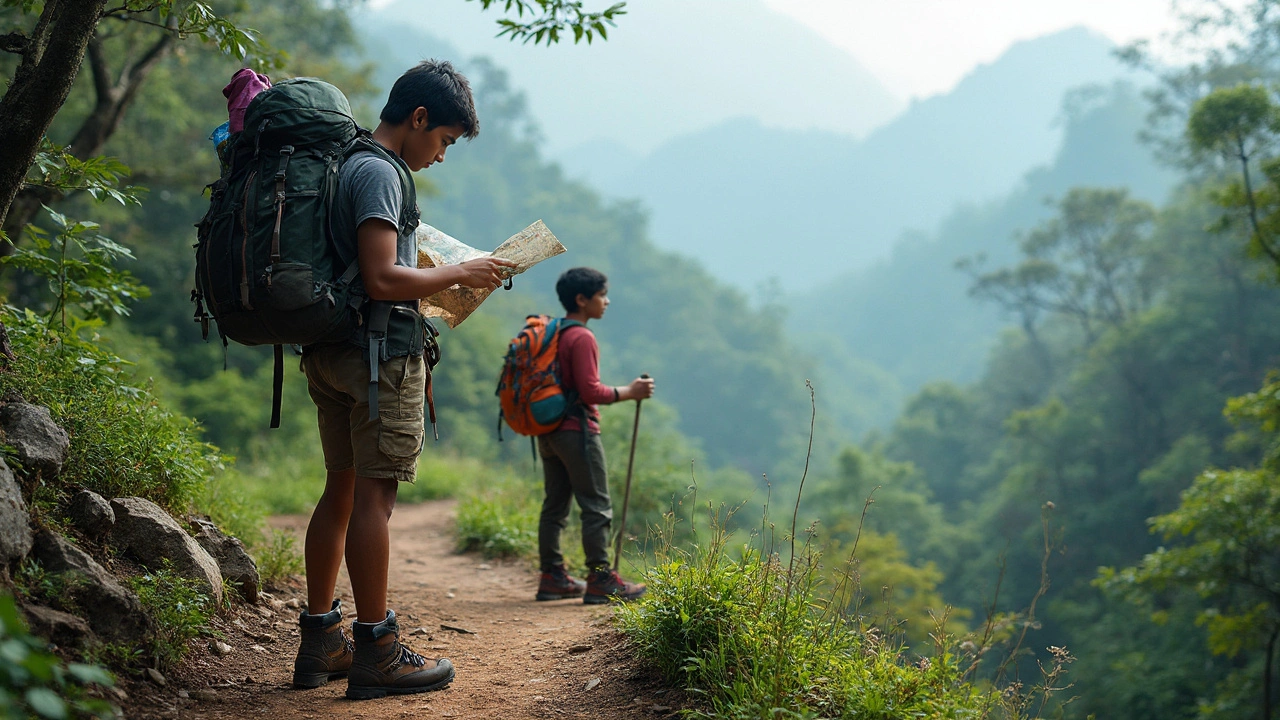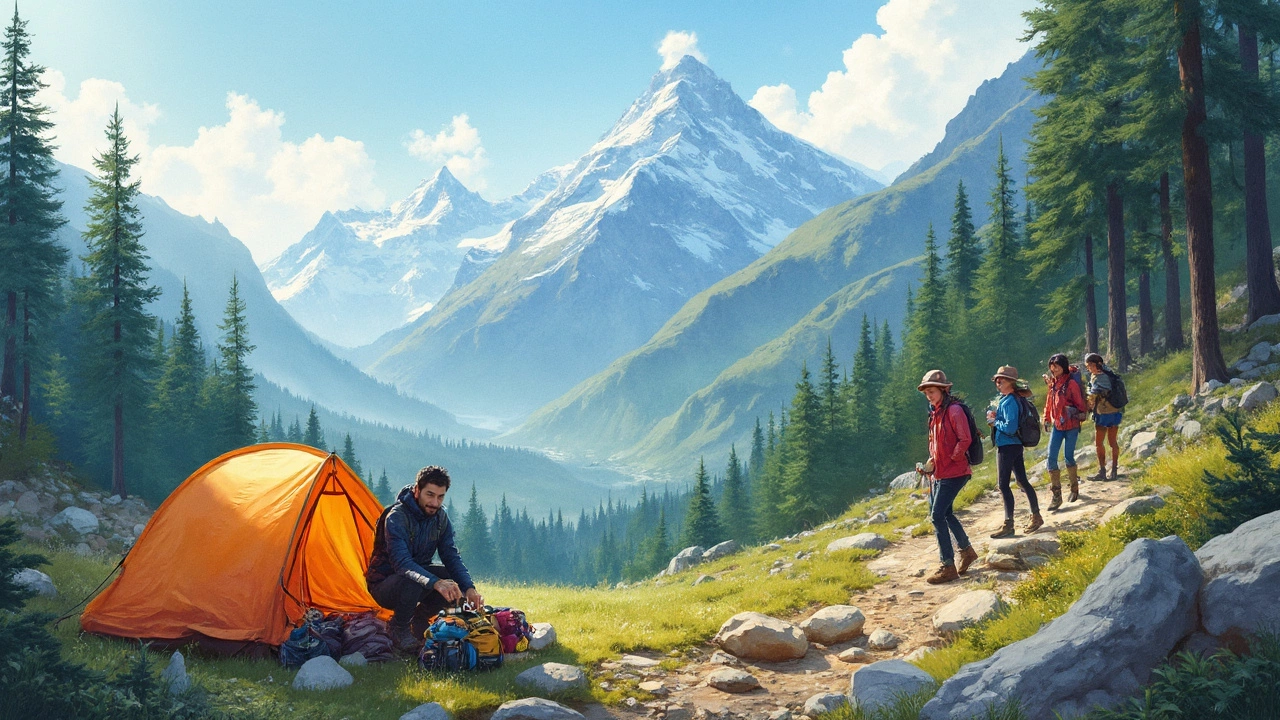Backpacking vs. Hiking: Unpacking the Differences and Similarities

- Jun, 24 2025
- 0 Comments
- Aaron Blackwood
Every year during the summer rush on Wellington’s red-dusted hills, you’ll see two classic breeds of outdoor enthusiast crossing each other on the tracks. One looks like they've packed for three weeks and a broken ankle; the other carries a sandwich, some water, and nothing but a grin. They both love nature, head into the wild, but are they actually doing the same thing? Backpacking and hiking get lumped together all the time, but ask anyone who’s hunkered down under a sopping tent after a ten-hour trudge—you'll hear how different the experiences really are.
What is Hiking, Exactly?
Let’s not overcomplicate things: hiking is essentially walking in nature, often along a trail, for pleasure. That’s the gist. Most hikers head out for a day trip, maybe a brisk three-hour blast around Zealandia, or an ambitious scramble up Mount Kaukau, but at the end of the day—literally—they go home, have a hot shower, and sleep in a bed. The real magic is the simplicity. With hiking, you’re mostly moving light and fast. Most folks bring a daypack with a drink bottle, windproof jacket, snacks, maybe a map or GPS, and that’s about it. Up to 80% of hikers in New Zealand stick to day hikes. The Department of Conservation (DOC) records over 1.5 million annual day hikes on managed trails, more than any other outdoor activity.
You don’t need to be an elite athlete to hike. In fact, the accessibility of hiking is what keeps it so popular. Children, families, and retirees all jump in. Trails are graded from easy to hard. For example, you’ve got the gentle Skyline Walkway (12km, mostly flat) or the much tougher Tararua Alpine Crossing. The daily goal? Soak up the sights, smell the wildflowers, spot a tui or two, and maybe chat with a stranger at a lookout. No fretting about gear weight, calorie calculations, or keeping everything dry through a thunderstorm. Fun little fact—New Zealand’s longest marked hike, the Te Araroa Trail, clocks in at 3,000 km, but plenty just enjoy a portion in an afternoon.
Most hiking is physically manageable because you can tailor the length, speed, and location. Weekend warriors love knowing they can knock out a quick jaunt before lunch and be back to their regular lives by nightfall. You’re rarely far from safety, and if the weather turns, you’re home soon. Hiking calls for less commitment but rewards you with that natural recharge so many are after.
Backpacking: Hiking’s Wily Cousin
If hiking is like popping out for a coffee, backpacking is the overnight road-trip version of the same urge to roam. Backpacking means you carry everything you’ll need to sleep, cook, and survive for one or more nights—on your back. That means a tent or bivvy, sleeping bag, stove, food, extra layers, maybe even a tiny repair kit or first-aid gear. Pretty much your life, shrunken to what you can bear for days at a time. The pack weighs far more than a day-hiker’s. You’ll often cover more rugged terrain and rarely have a warm house nearby if things get hairy.
Here’s a cool stat: The Great Walks of New Zealand, famous backpacking tracks like the Milford, Kepler, and Abel Tasman, draw over 120,000 overnight trampers each year—even though you need to book spots months in advance. Many overseas backpackers come for this reason alone. With backpacking, you’re not just dabbling in the outdoors, you’re living it. When you sleep after ten hours of slogging through mud, you discover a new appreciation for dry socks and instant noodles.
Backpacking is a lesson in self-reliance. When you’re three valleys away from the car, you can’t pop down to the Four Square for a forgotten item. Packing lists are strategic—what weighs least, dries fast, does double-duty. You become a logistics manager, weather forecaster, medic, chef, and, if you’re lucky, campfire storyteller. Folks who’ve survived a night on a windswept ridge with only a flysheet for cover will tell you there’s a thrill in hardship—which is, let's face it, a bit odd, but always true. Mistakes cost more: get caught short on food, warmth, or navigation, and you’ll pay for it in misery.
Yet backpacking also builds a different bond with the wild. You actually hear kiwi birds at night, see glowworms after midnight, and get a chance to wake up with dew on your tent—and the world looking so quiet it tugs at something primal. There’s a reason backpackers tend to get philosophical after a few nights away from Wi-Fi. They’ve often walked through wild weather, navigated raging creeks in bare feet, or found themselves improvising shelter with whatever’s handy. Each trip hands you stories you’ll swear were taller than the mountains you slept beneath.

Similarities Between Backpacking and Hiking
Let’s not pretend these are two different universes. Some people use “hiking” and “backpacking” interchangeably, and there’s truth to it—they both set out on foot across nature, savoring sky and wind, usually following trails. Your main goal is the same: move through the landscape under your own steam. Whether you’re carrying a sandwich or your whole kitchen, the appeal lies in that break from regular life, phones, and paved roads.
Both activities demand some know-how. Trail etiquette is a universal: leave no rubbish, respect wildlife, let uphill hikers pass, and give a cheerful hello (“Kia ora!” is the local favorite). Both call for trusted footwear—boots or trail runners, blister-proof socks, and a knack for not tripping over roots. And the rewards? They’re the same too: the way the light hits the flax at dawn, or that energy buzz you get from cresting the last rise.
Fitness is a shared requirement, but you don’t need to be superhuman. Regular walkers do just fine. You check the weather before setting out and keep an emergency whistle handy. Both hikers and backpackers snack a lot, often on muesli bars, dried fruit, or that classic odd couple, chocolate and jerky. Water is always top of mind—most local parks have potable sources and DOC huts for refills, but further into the bush, backpackers often filter or boil creek water for safety.
The social side is similar too. Both hikers and backpackers form tight little tribes. Most who try multi-day trips started with short hikes, levelled up as they learned what worked for them, and got hooked when the first view made the gear schlepping fade into memory. Both activities often see old friends swapping epic yarns about blisters and wild weather around a hut stove or at a summit cairn.
If you’re new to either, the starter tips overlap: do a practice run with your pack, break your boots in before any big mission, let someone know where you’re headed, and always bring a charged phone—signal’s patchy, but the GPS still works on airplane mode. And seriously, learn how to read a paper map; batteries and electronics fail, but topography never lies.
Key Differences That Change the Game
Here’s where things split. The differences between backpacking and hiking come down to commitment, risk, gear, and your relationship to the wild. Hikers opt in and out by the hour; backpackers settle in for the long haul. If things go bad for a hiker, help is closer and safety is less of a gamble. With backpacking, isolation and weather magnify everything—what’s a mild drizzle on a day trip can be a bone-chiller when you’re three river valleys away and heading into your second soggy night.
Backpacking gear is a world unto itself. Here’s a comparison nicely broken down in a table:
| Item | Day Hiking | Backpacking |
|---|---|---|
| Pack Weight | 3-7 kg | 12-20 kg |
| Duration | 2-8 hours | 1-10 days (or more) |
| Shelter | None, emergency bivvy | Tent, hammock or tarp |
| Food | Snacks, one meal | Full meals for duration |
| Water | 1-2 litres, refill points | Purification method often required |
| Navigation | Marked trails, phone/app | Map, compass, route-finding skills |
| Clothing | Weather-appropriate layers | Extra layers for nights, emergencies |
| Risk | Lower (close to help) | Higher (remote) |
For backpacking, your physical and mental stamina matter. Carrying 18 kilos up through the Harris Saddle? Your legs and willpower better be friends. A study from Otago University found multi-day trekkers burn between 3,500–5,000 calories a day—double what a typical hiker uses. Everything you carry has to be justified. Forget something for a day hike and it’s annoying; forget it for a week-long tramp, and you’re in for some creative problem-solving.
Trail choice is part of it, too. Day hikers stick to well-marked, shorter loops, often in areas with cell coverage or close to roads. Backpackers, meanwhile, disappear into New Zealand’s true wilderness—places where even popular Great Walks like the Routeburn or Heaphy can feel eerily empty once camp settles for the night. The sense of autonomy sharpens the senses. Backpackers rehearse their self-reliance and safety skills: river crossings, emergency shelter setups, knowing when to turn back. Hiking, by contrast, is more about the journey than the destination because getting into trouble is less likely, and you’re rarely far from help.
And hey, there’s a social difference too. Day hikers mingle at trailheads, swap quick tips, and might share a thermos at the summit, but everyone’s off home soon. Backpackers get to know their trailmates fast—when you’ve spent four days sharing a hut with the same crew, swapping gear or splitting noodles, friendships often stick. Multi-day adventures force everyone to drop social pretences. By day three, nobody cares about looking glamorous; you bond over mud and shared stories.
If you ever want to push the boundaries, try both and notice what changes. Maybe start with short hikes on Wellington’s town tracks, then plan a light overnight trip to a nearby DOC hut. You’ll find yourself clocking every gram in your pack, checking the forecast with almost religious fervour, practising tying off blister plasters, and finally tasting dinner beneath a southern night sky while paradoxically desperate for a hot shower and never wanting to leave.
End of the day, backpacking and hiking both scratch the adventure itch, but the stakes, planning, and sense of accomplishment ramp up the longer you stay out there. Whether you want a flash of escape or a full episode of wild living, the choice is yours—the mountains won’t mind either way. See you out there on the track.